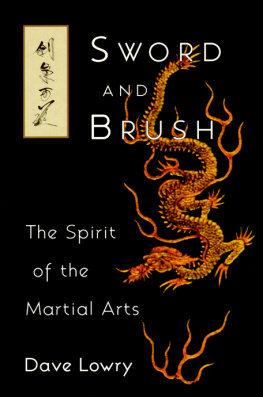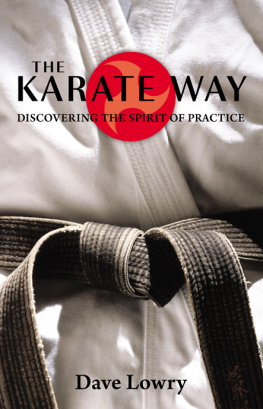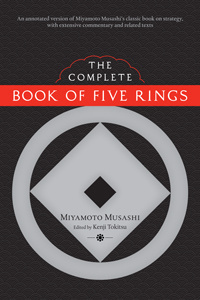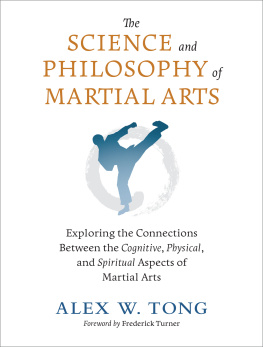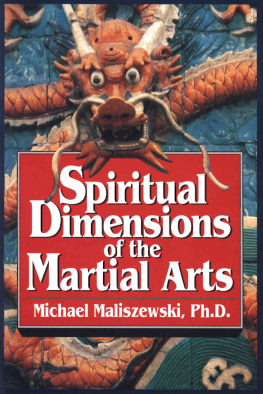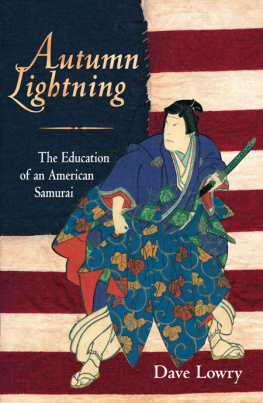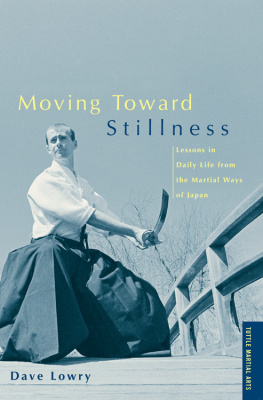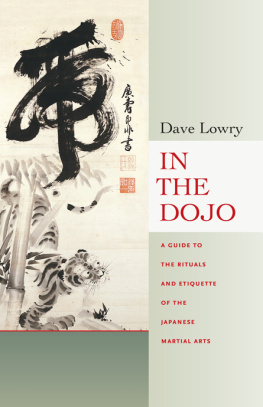Dave Lowry - Sword and Brush: The Spirit of the Martial Arts
Here you can read online Dave Lowry - Sword and Brush: The Spirit of the Martial Arts full text of the book (entire story) in english for free. Download pdf and epub, get meaning, cover and reviews about this ebook. publisher: Shambhala, genre: Religion. Description of the work, (preface) as well as reviews are available. Best literature library LitArk.com created for fans of good reading and offers a wide selection of genres:
Romance novel
Science fiction
Adventure
Detective
Science
History
Home and family
Prose
Art
Politics
Computer
Non-fiction
Religion
Business
Children
Humor
Choose a favorite category and find really read worthwhile books. Enjoy immersion in the world of imagination, feel the emotions of the characters or learn something new for yourself, make an fascinating discovery.
- Book:Sword and Brush: The Spirit of the Martial Arts
- Author:
- Publisher:Shambhala
- Genre:
- Rating:4 / 5
- Favourites:Add to favourites
- Your mark:
- 80
- 1
- 2
- 3
- 4
- 5
Sword and Brush: The Spirit of the Martial Arts: summary, description and annotation
We offer to read an annotation, description, summary or preface (depends on what the author of the book "Sword and Brush: The Spirit of the Martial Arts" wrote himself). If you haven't found the necessary information about the book — write in the comments, we will try to find it.
Dave Lowry: author's other books
Who wrote Sword and Brush: The Spirit of the Martial Arts? Find out the surname, the name of the author of the book and a list of all author's works by series.
Sword and Brush: The Spirit of the Martial Arts — read online for free the complete book (whole text) full work
Below is the text of the book, divided by pages. System saving the place of the last page read, allows you to conveniently read the book "Sword and Brush: The Spirit of the Martial Arts" online for free, without having to search again every time where you left off. Put a bookmark, and you can go to the page where you finished reading at any time.
Font size:
Interval:
Bookmark:
ABOUT THE BOOK
This moment of perfect clarity that is the force behind all the traditional Japanese artsfrom archery to flower arrangingis celebrated here in Dave Lowrys exploration of the common principles shared by calligraphy and the martial arts.
Forty-two examples of Lowrys calligraphy, accompanied by his essays, show how the way of the brush reflects the strategic principles of the way of the sword. Each calligraphy represents a term from the martial artssuch as do, the way, or wa, harmony. The accompanying text amplifies our understanding of the term, what it meant to Japanese warriors, and what it means to practitioners of calligraphy and the martial arts today. What becomes clear is that these two seemingly unrelated disciplines actually partake of the same profound elemental spirit.
DAVE LOWRY is an accomplished martial artist, calligrapher, and writer. He is the restaurant critic for St. Louis Magazine and writes regularly for a number of magazines on a wide variety of subjects, many of them related to Japan and the Japanese martial arts. He is the author of numerous books, including Autumn Lightning: The Education of an American Samurai, Clouds in the West: Lessons from the Martial Arts of Japan, and The Connoisseurs Guide to Sushi.
Sign up to learn more about our books and receive special offers from Shambhala Publications.

Or visit us online to sign up at shambhala.com/eshambhala.
SWORD AND BRUSH
THE SPIRIT OF THE MARTIAL ARTS
Dave Lowry

SHAMBHALA
Boston & London
2013
Shambhala Publications, Inc.
Horticultural Hall
300 Massachusetts Avenue
Boston, Massachusetts 02115
www.shambhala.com
1995 by Dave Lowry
All rights reserved. No part of this book may be reproduced in any form or by any means, electronic or mechanical, including photocopying, recording, or by any information storage and retrieval system, without permission in writing from the publisher.
Library of Congress Cataloging-in-Publication Data
Lowry, Dave.
Sword and brush: the spirit of the martial arts/Dave Lowry.
p. cm.
eISBN 978-0-8348-2542-0
ISBN 1-57062-112-8
1. Martial artsJapanPhilosophy. 2. Calligraphy, Japanese.
I. Title.
GV1100.77.A2L68 1995 95-5653
796.80952dc20 CIP
To Pat Lineberger, sempai

During the 1980s a fortuitous sequence of events occurred. Primus: I found a book that described Japanese swordwork as I, an aikidoka, understood it. Secundus: I needed some information about Tesshu Yamaoka, the nineteenth-century sword genius. Tertius: I wrote to the author of the book on swordsmanship for clues on tracking Tesshu. Quartus: he wrote back. Thus I made the epistolary acquaintance of Dave Lowry, one of this worlds more fascinating human beings.
Dave is a unique young man: a Yagyu Shinkage swordsman; a spiritual descendant of Cotton Mather; a karateka who writes about karate in popular magazines (and has the least popular opinions possible); a historian; an aikido practitioner who realizes the self-contradictory behavior of many leading aikidoka; an expert on gravestones; a student of the very rough and tough Shindo Muso ryu staff fighting; a medical writer; a cultured gentleman who speaks old-fashioned Japanese; a passionate Puritan; an ethnologist; a reasonably capable theologian; a weapons expert; a devoted family man; a lover of bird-watching, good wines, Japan, and New England who pursues his literary life in Missouri; a controversial scribe who can seem opinionated and arrogant but who is at center a man of deepest humilitywho might well object vociferously to my describing him as humble.
In almost four decades in martial arts and Ways, I have never been so stimulated by anyones writings as I have by Dave Lowrys. His letters are works of unself-conscious art, born from years of sweat in many a dojo. Not a dilettante littering the world with worthless notions, he is a true scholar of budo well worth hearing.
And seeing. As the brushwork in this book testifies, Dave is a consummate artist with the brush as well as with the sword and the word. Although I have been playing with sumi-e for thirty years, seeing Daves work is very good for my humility.
I am honored to be able to commend to you this important contribution to our understanding of budo and of Japanese culture. In it we can see the truth of the maxim, Ken fude ittai, the sword and the brush are one entity.
THE REVEREND CANON DOUGLAS SKOYLES
Church of Saint John the Evangelist,Calgary, Alberta

My sincerest thanks to all my dohai and seniors who have shared their insights on the Way: Messrs. Muromoto, Amdur, Bieri, Skoyles, Cieslik, Bates, Pittman, and Mesdames Usuda and Iida.
My gratitude to Ellis Amdur for reading the manuscript.
Thanks, too, to Swoboda and his staff at Wash. U., for their assistance and companionship, and to Jan, for lugging all that paper around. Finally, to my kanai and to my boy, who tolerated an ink-splattered summer.
DAVE LOWRY
St. Louis
July, Tanabata, 1994

The stroke is executed by cutting back, then down, is the teaching given in an ancient scroll, followed by a swift, slight rise to the right like the movement of striking with a whip.
Another scroll, almost equally antique, contains poetic, if enigmatic, advice about the practitioners state of mind, likening it to a flower scattering, falling without sound on moss, a flower scattering to be heard through the depths of mountains.
Only those unacquainted with the paradoxes of art in Japanese culture would be surprised to learn that the first commentary is concerned with the gentle skills of calligraphy, the second devoted to the perfection of warriorship with the sword. At the core, the particulars of instruction, the matters of detail in effectuation contained in these old scrolls, are secondary to learning either art. It is the underlying principles that are of utmost concern, and these principles, in a broad range of Japanese artsfine, folk, performing, and martialare fundamentally synonymous. These principles are crucial to the mastery of any and all.
The actor in the Noh drama strives to make his way across the stage without a gap in his concentration, without a single superfluous movement. There is a sense of awareness of self and place surrounding the Noh actor that is understood perfectly by the warrior in the perilous arena where he performs. The shakuhachi flutist plays his instrument from his body center and perfects his breathing. The swordsman strikes from his center and the efficacy of his blow is assured by a proper attention to his own respiration. The goals differ, the attitude is identical.
It is not only in technical aspects that the varied endeavors of the traditional Japanese arts converge. From flower arranging to tea ceremony to archery, the aesthetics, the spirituality, and the motivations of these apparently disparate arts have a marvelous commonality. The unity of these artistic forces is exemplified in two disciplines, seemingly discrete, both at the very heart of Japan: the Way of the sword and the Way of the brush.
Next pageFont size:
Interval:
Bookmark:
Similar books «Sword and Brush: The Spirit of the Martial Arts»
Look at similar books to Sword and Brush: The Spirit of the Martial Arts. We have selected literature similar in name and meaning in the hope of providing readers with more options to find new, interesting, not yet read works.
Discussion, reviews of the book Sword and Brush: The Spirit of the Martial Arts and just readers' own opinions. Leave your comments, write what you think about the work, its meaning or the main characters. Specify what exactly you liked and what you didn't like, and why you think so.

